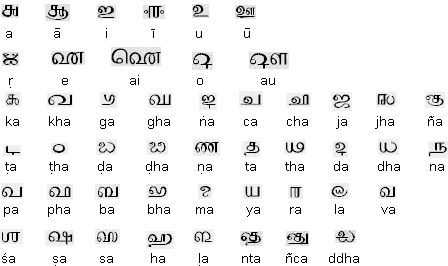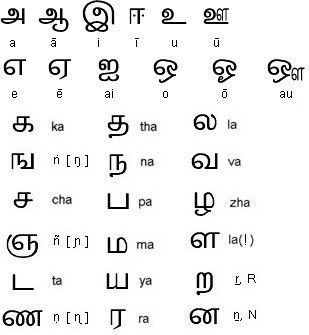
The Grantha alphabet is a descendent of the Brahmi alphabet and started to emerge during the 5th century AD.
Sanskrit was transmitted orally for a long time, and so was mostly written in the local script. (It is only in recent times, since Sanskrit was introduced in the modern universities, that the Devanagari was adopted as the standard.) In Bengal, it was written in the Bengali script; in Andhra, in the Telugu script.

The last three consonants are example of conjuncts.
Total alphabets are about 48 in number, without the Dravidian characters like the ra and zha. Granthakshara was used to write Sanskrit in Kerala before Ezhuthachan's time. Vattezhuthu used as Malayalam alphabet during that time is similar to Tamil and is given for comparison.
Vattezhuthu was the early script used to write Malayalam. Total alphabets were about 30.
From the vattezhuthu was derived another script called the kolezhuthu. There is no fundamental difference between the two scripts except that in kolezhuthu there are no specific symbols for endings in u and for a and o. This script was more commonly used in the Cochin and Malabar areas than in Travancore. Yet another script derived from the vattezhuthu was the Malayanma, which was commonly used south to Thiruvananthapuram. Malayanma also does not differ fundamentally from the vattezhuthu.

The absence of character combinations, the vowels a and o and conventions for symbols were real difficulties in Vattezhuthu. The trouble with kolezhuthu was still more, for it had regional variations also. And in the case Malayanma, the complexity of the script, Tamil usage and conventional abbreviations for words made it unintelligible to the rest of the region. With all these three scripts in current use the writing and reading of Malayalam must indeed have been a difficult affair.
Tamil is a Dravidian language spoken mainly in Tamil Nadu and Sri Lanka. The Tamil alphabet is descended from the Brahmi script of ancient India. The earliest known Tamil inscriptions date back to at least 500 BC.

Total alphabets are 30 in number as Vattezhuthu, and the consonants have got the same limitations to write Sanskrit.
In the Tamil region, the script used to write Sanskrit was (and to this day in traditional patasalas is) Grantha. The situation was similar in Kerala before Ezhuthachan's time.
The Devanāgarī ('divine Nagari') alphabet descended from the Brahmi script sometime around the 11th century AD. It was originally developed to write Sanksrit but was later adapted to write many other languages. It is only in recent times, since Sanskrit was introduced in the modern universities, that the Devanagari was adopted as the standard.
Total alphabets about 48, without the Dravidian characters.
Hindi uses the same script and hence Devanagiri is not reproduced here.
Devanagiri is also used to write Marathi, Pali, Sindhi and many more.
The ancient alphabet system of India, Brahmi alphabet is the ancestor of most of the 40 or so modern Indian alphabets, and of a number of other alphabets, such as Khmer and Tibetan. It appeared in India sometime before 500 BC. There is a theory that Brahmi developed from the Indus or Harappa script, which was used in the Indus valley until about 2,000 BC.
The earliest known inscriptions in the Brahmi alphabet are those of King Asoka (c.270-232 BC), third monarch of the Mauryan dynasty.
Brahmi was used to write Sanskrit, Prakrit and other languages also. Total alphabets are approximately 44. The vowels and consonants are of the same order as that of the later scripts used to write Sanskrit.
AI Website Maker